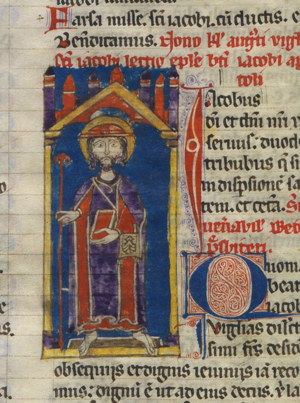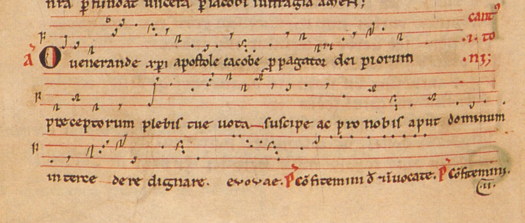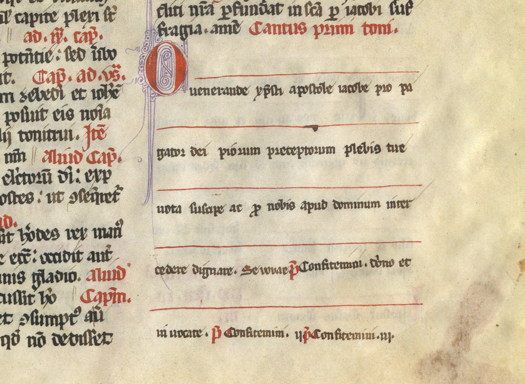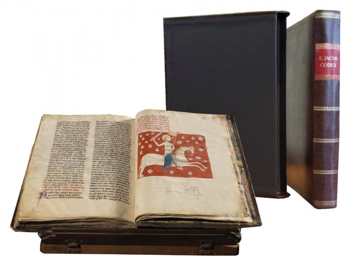| Of these sources the manuscript preserved in Compostela, Archivo de la Catedral, 1130s
with additions around 1173 (known in the literature as Ms
C) , is undoubtedly the most important. It is illustrated, it has the most complete music (including the supplement of polyphonic pieces after the Pilgrim’s guide) and it is the earliest; at least four sources are in fact copies of it. A faithful facsimile edition of Ms. C was produced in 1993. Although
the
essence
of
JACOBUS generally has been understood to be "Spanish", it has been demonstrated to be the result of strong French cross-fertilization, in the political, religious and cultural spheres. The standard colophon in the surviving sources doesn't hide this fact ("this codex was put together in several places sofar as known, in Gallica . . . and mainly in Cluny"—and thanks to the work of Michel Huglo the "new" chants for St. James contained in Ms. C seem to have originated from Central France, namely from the Church of the Madeleine in Vezlay around Nevers, just 75 miles from Cluny.
Students and scholars of the camino are now fortunate to have a second facsimile of Codex Calixtinus, based on the Salamanca copy. Known as Ms. S, and copied around 1325 in Santiago de Compostela, this copy counts as one of four complete (long) versions of the Jacobus compilation and at the same time one of four that are illustrated. According to M. Alison Stones the meagerness of Jacobus transmissions is a bit baffling—compared to about 200 sources for the Historia Turpini (Book IV), so the facsimile of the Salamanca source is all the more welcome. Telltale aspects of Ms. S (e.g., its compact 2-column layout and the use of the word "curia" instead of "Rome" and variant spelling of Cluny in the colophon) show it has a slightly different lineage from Ms. C, and in that way the text and illustrations offer the historian new insights and challenges. Salamanca comes down to us without title page and the initial portrait of Pope Calixtus has been vandalized, however, other than this, the manuscript is beautifully executed and adorned with 5 outstanding illuminations, two of them whole pages. Although Salamanca provides full texts for the chants for the office and mass of St. James, in a format that utilizes a single pitch reference line (usually denoting C or F interval), the compiler didn't get around to enter the pitches for the chants. The examples provided below show the treatment of the Antiphon O venerande christi in Mss. C and S; interestingly Ms. C, with its clear diastematic notation of Central France, actually seems more "modern" than the simple single-line notation of Salamanca, but this difference is typical of musical manuscripts coming from different geographic locations and periods; here Salamanca has "updated" the French notation using current Spanish conventions.
Antiphon. O venerande christi apostole iacobe (Ms C) (click on image to enlarge)
Antiphon. O venerande christi apostole iacobe (Ms S) (click on image to enlarge)
If Salamanca had notation what would it look like? The Vida de San Lesmes (Burgos, Monasterio de Cistercienses Calatravas de San Felices), is a good clue, as it is a manuscript from the same time period and milieu.
|
| 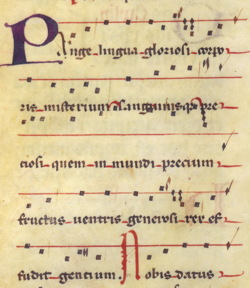 |
|
Colophon of Salamanca and final illumination (Santiago Matamoros) -
"Here ends the fifth book of the Apostle Santiago, glory be to the writer and the reader. This codex was received diligently by the Roman Church as it was put together in several places so far as known, in the Curia, in the land of Jerusalem, in Gallia, in Italia, in Teutonica, and Fresia and mainly in Cluny"
|
|
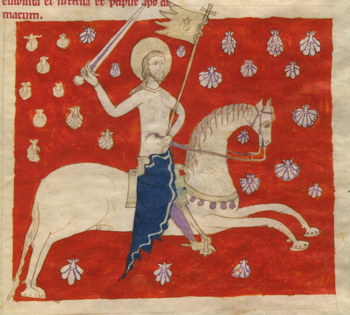
(click
on
image
to enlarge)
|
|
| click on image to enlarge click on image to enlarge
The extant manuscripts of the Liber Sancti Jacobi
(source: The Pilgrim's Guide to Santiago de Compostela, A Critical Edition and Annotated Translation: The Manuscripts by Alison Stones and Jeanne Krochalis; The Text, by Paula Gerson, Jeanne Krochalis, Annie Shaver-Crandell, Alison Stones. London: Harvey Miller, 1998)
Long version, illustrated
C (Archivo, Catedral de Santiago de Compostela;
1138-40; 1173, France/Santigo)
A (London, British Library, add. 12213, c.1325,
Santiago; direct copy of C)
VA (Vatican, Bibl. Apost. Vaticanus, San Pietro C
128, c.1352, Santiago; direct copy of C)
S (Salamanca, Biblioteca de la Universidad,
c.1325, Santiago)
Long version, unillustrated
T (London, British Library, Cotton Titus A XIX,
14th c, York & Kirkstall)
P (Pistoia, Archivio di Stato, Doc. vari 27, aft.
1524, Pistoia)
M (Madrid, Biblioteca Nacional, 4305, 1538,
Santiago)
SV (Madrid, Biblioteca Nacional, 7381, 1657,
Estepa)
Special version
L (Lisbon, Biblioteca National, Codices
Alcombaçences CCCII(334), 12- 13th c,
Alcobaça or Lovao)
Short version
R (Barcelona, Arxiu de la Corona de Arago, Ripoll
99, 1173, Santiago)
VB (Vatican, Bibl. Apost. Vaticanus, Borghese 202,
14th c, Zaragoza)
Z (Madrid, Biblioteca Nacional, 13118, c.1750,
Toledo, antiquarian's collection of historical
documents)
List of illuminations in the Salamanca copy:
[1]
portrait of Pope Calixtus - missing (fol. 1)
2 - St. James as pilgrim (f. 2v)
3a - Charlemagne's dream (f. 90)
3b - Charlemagne and the army setting out with
Roland carrying a banner
3c - Charlemagne's army brandishing spears
4 - Turpin witnessing the tranportation to heaven
of the souls of
the
dead
warriors
of Roncesvalles
(f. 91v)
5 - James Matamoros (f. 120)
|
|
|
